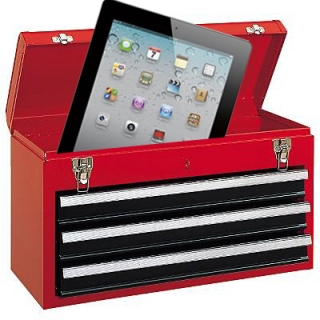Mrs. Parnell shared an enlightening lesson about electricity! Thanks to hands on resources from the Science Center we were able to test various items to see if they are conductors or non-conductors(insulators). Then we created electrical circuits! ( A lot like a circle!) We created light and sound. Be sure to check with your child and ask him/her about the fun we had this week testing out the ways electricity works!
Thursday, December 13, 2012
Day 44 - Mrs. Parnell and Mrs. Hoyt, Pine Glen Elementary School
Our lesson was Electrifying!
Mrs. Parnell shared an enlightening lesson about electricity! Thanks to hands on resources from the Science Center we were able to test various items to see if they are conductors or non-conductors(insulators). Then we created electrical circuits! ( A lot like a circle!) We created light and sound. Be sure to check with your child and ask him/her about the fun we had this week testing out the ways electricity works!

Mrs. Parnell shared an enlightening lesson about electricity! Thanks to hands on resources from the Science Center we were able to test various items to see if they are conductors or non-conductors(insulators). Then we created electrical circuits! ( A lot like a circle!) We created light and sound. Be sure to check with your child and ask him/her about the fun we had this week testing out the ways electricity works!
Wednesday, December 12, 2012
Day 44 - Burlingtion High School, Student Help Desk
Stick and find bluetooth powered stickers
We have all lost one thing that we really need to find to help us with our daily lives. For some people you have maybe lost your keys, or maybe the TV remote. Well now there is a solution to find them with ease. This product from indiegogo, and is made to stick to any object. The size of a quarter, its battery lasts for a year, and has a range of up to 100 feet. The app sends out a signal to your phone if you are trying to find the lost object. It is not on the app store yet, but when the product is for sale, the application will be published. You can make the sticker have an audible buzzer, or a blinking red light so you can find it in the dark. The stick and find will sell for $49.95 for a package of two. Watch the video below to learn more.

We have all lost one thing that we really need to find to help us with our daily lives. For some people you have maybe lost your keys, or maybe the TV remote. Well now there is a solution to find them with ease. This product from indiegogo, and is made to stick to any object. The size of a quarter, its battery lasts for a year, and has a range of up to 100 feet. The app sends out a signal to your phone if you are trying to find the lost object. It is not on the app store yet, but when the product is for sale, the application will be published. You can make the sticker have an audible buzzer, or a blinking red light so you can find it in the dark. The stick and find will sell for $49.95 for a package of two. Watch the video below to learn more.
Tuesday, December 11, 2012
Day 43 - Burlington Science Center Staff
The Gutterboat Challenge

On the final day anticipation builds as each student gets the chance to race against the clock on the main stage. Not all boats are successful but all present a learning opportunity. The winning time of Pine Glen’s Gutterboat Challenge this year 07.05 seconds. Can’t wait to see if that time will be topped at another school!
Every year, Burlington fifth graders put their engineering skills to the test in “The Gutterboat Challenge,” a friendly competition between students (and classes!) to see who can build the fastest styrofoam-hull boat. While the type of fan varies from school to school, all students must design and construct a boat that can travel the distance of a plastic gutter, much like the one you might find on a home!
All students are provided with a block of styrofoam and the instructions that they may use any materials available to them at home or school. They are also instructed on the design or engineering process through an introductory lesson by Mr. Musselman before being left to their own research on boat design and collaborative brainstorming.
The entire challenge takes between one to two weeks with an opportunity to do a “test run” in between the introduction and final testing phase. It is here many students find flaws with their boats (too light, unable to catch wind, unbalanced, etc.) that they are then expected to redesign and adjust.
On the final day anticipation builds as each student gets the chance to race against the clock on the main stage. Not all boats are successful but all present a learning opportunity. The winning time of Pine Glen’s Gutterboat Challenge this year 07.05 seconds. Can’t wait to see if that time will be topped at another school!
Friday, December 7, 2012
Day 42, Lynda Bannon, Memorial School Physical Education Staff
Make Plans to Beat the Winter Blues
Our first marking term has come to a close and all Memorial students have received individual reports on gross motor skills (grades 1-2) and fitness reports (grades 3-5).
Parents are encouraged to utilize these reports to ensure the best possible skill and fitness levels for their son/daughter. No matter what level your child is at, there is always room for improvement.
Remember everyone needs exercise.
Play catch or get your children to go for a walk or run with you.
FYI: A recent Newsweek cover story cited recent brain research that showed how exercise is not only good for overall general health but also for learning, memory and higher-order thinking. Less than an hour after a vigorous workout, your brain is working better.
Important Tips to Remember:
A healthy body needs daily exercise...
60 minutes of cardiovascular exercise
(bike, run, swim, walk)
Exercise once a week is NOT enough!
Make a game plan and stick to it for the best results...
A body in motion tends to stay in motion, a
body at rest tends to stay at rest.
Activity ideas for the Winter months:
Sledding- walking up hill
Snow Shoeing
Cross Country Skiing
Brisk walking (mall walking)
Join a Health Club (Swim)
Please Do Not Go into Hybernation...
Good Health and Fitness require consistency
Happy Exercising
Thursday, December 6, 2012
Day 41 - Wendy Pavlicek, Burlington Science Center
Is it snowing outside? No, it’s winter moths!
The winter moth, an invasive insect originally from Europe, was introduced into the United States through Canada and Nova Scotia before the 1950′s. You can see these moths throughout eastern Massachusetts in huge numbers.

The adult winter moths (Operophtera brumata) emerge from the ground in November or December, but only the male is able to fly. The female climbs to the base of a tree or building and attracts the male through the pheromone (scent) that she gives off. After mating, the female lays a cluster of approximately 150 eggs under tree bark or in tree crevices, and her life is now over. In March or April the eggs hatch into a smooth green inchworm with a narrow white-stripe running lengthwise on each side of the body. The caterpillar spins a strand of silk, which, with the help of air currents, takes it into tree canopies in a dispersal method known as “ballooning”.
Once there, the damage to the tree begins as the caterpillars work their way into the tree buds and leaves to feed. In Massachusetts, the tree species frequently affected are maple, oak, ash, as well as fruits producers such as apple, crabapple, and blueberry. Winter moth caterpillars can also drop from trees to nearby ornamental shrubs such as roses. When feeding ends in mid-June the caterpillars migrate into the soil to pupate and emerge as moths.

What can we do to control this moth?
No natural controls are known to be present in Massachusetts, but researchers at the University of Massachusetts in Amherst are actively collecting and rearing a parasitic fly (Cyzenis albicans) that was very effective at controlling winter moth outbreaks in eastern Canada and the Pacific Northwest. Unfortunately, effective biological control is many years away.
Source:http://extension.umass.edu/
Check out these links for more winter moth information:
http://extension.umass.edu/landscape/news/warm-winter-2012-and-what-expect-winter-moth-massachusetts
http://extension.umass.edu/landscape/fact-sheets/winter-moth-overview
http://extension.umass.edu/landscape/fact-sheets/winter-moth-identification-management
http://www.mass.gov/dcr/news/winter_moth.pdf

The winter moth, an invasive insect originally from Europe, was introduced into the United States through Canada and Nova Scotia before the 1950′s. You can see these moths throughout eastern Massachusetts in huge numbers.

The adult winter moths (Operophtera brumata) emerge from the ground in November or December, but only the male is able to fly. The female climbs to the base of a tree or building and attracts the male through the pheromone (scent) that she gives off. After mating, the female lays a cluster of approximately 150 eggs under tree bark or in tree crevices, and her life is now over. In March or April the eggs hatch into a smooth green inchworm with a narrow white-stripe running lengthwise on each side of the body. The caterpillar spins a strand of silk, which, with the help of air currents, takes it into tree canopies in a dispersal method known as “ballooning”.
Once there, the damage to the tree begins as the caterpillars work their way into the tree buds and leaves to feed. In Massachusetts, the tree species frequently affected are maple, oak, ash, as well as fruits producers such as apple, crabapple, and blueberry. Winter moth caterpillars can also drop from trees to nearby ornamental shrubs such as roses. When feeding ends in mid-June the caterpillars migrate into the soil to pupate and emerge as moths.

What can we do to control this moth?
No natural controls are known to be present in Massachusetts, but researchers at the University of Massachusetts in Amherst are actively collecting and rearing a parasitic fly (Cyzenis albicans) that was very effective at controlling winter moth outbreaks in eastern Canada and the Pacific Northwest. Unfortunately, effective biological control is many years away.
Source:http://extension.umass.edu/
Check out these links for more winter moth information:
http://extension.umass.edu/landscape/fact-sheets/winter-moth-overview
http://extension.umass.edu/landscape/fact-sheets/winter-moth-identification-management
http://www.mass.gov/dcr/news/winter_moth.pdf
Wednesday, December 5, 2012
Day 40 - Andrew Dexter, Marshall Simonds Middle School Media Specialist

On Monday’s Professional Development Day, Marshall Simonds teachers were presented an overview of the 1:1 iPad plan by Assistant Superintendent Patrick Larkin, Director of Technology Integration Dennis Villano and the BPS Ed Tech Team. Beyond logistical details, the teachers were given time to learn about foundation apps and load them onto their iPads. Andy Marcinek and Tim Calvin, who both work at BHS as Educational Technology teachers provided MSMS staff with vital insight on how the 1:1 environment can provide teachers and students with a more engaging learning environment. The staff also had the benefit of learning from BHS Help Desk students Sidd Chhayani and RJ Dalton.
MSMS has had the advantage of being on the cutting-edge of technology for many years, so this transition will be a smoother one compared with many other schools. Dennis Villano mentioned during his presentation,
“Teachers at MSMS have always been willing to try new things.”
The foundational apps mentioned during the PD day were:
The iPad is simply another tool to add to the teacher’s toolbox. It is very exciting to see the potential of the 1:1 environment starting to take shape. I am sure this exciting learning environment will have its growing pains, but I am very excited about what is to come.
-Mr. Dexter, Library Media Specialist
Tuesday, December 4, 2012
Day 39 - Trevor Dorazio, Burlington High School Junior
My Statue Capture
123D Catch App
123D Catch App
Just imagine, anything you can see can be made into a 3D object on your iPad. This is what the developers at Autodesk have been working on and putting out in the app 123D Catch. Along with several other 3D developing apps on the iPad by Autodesk, this one in particular is interesting because the user can actually take the pictures in order to create the 3D image.
The team at Autodesk has been trying to develop ways to more easily integrate everyday people into making complicated 3D designs, causing more people to go take that extra step into learning more about the industry and eventually go into business using such a technology as the interest and market for it grows. There is currently a version to download on a PC or Mac, an online version, and an app.
Using the app, I have captured and recreated some familiar objects such as, the lower library stairwell, the lower library yellow submarine, the pedestal outside the main lobby door and William Duffy’s statue inside the main door of the school. There is an in-app gallery to share and discover other peoples’ captures, as long as they decide to post them.
I shared my statue capture and the developers took it and put it in their “featured” section, a true honor to have the original artists find my capture appealing enough my capture enough to feature among all the other captures from the many people who post their own. As an extra feature, it is possible to print out your 3D capture from a 3D printer and have a physical model of what you created on your iPod, iPad or computer.
Autodesk’s Intro. to 123D Catch
The team at Autodesk has been trying to develop ways to more easily integrate everyday people into making complicated 3D designs, causing more people to go take that extra step into learning more about the industry and eventually go into business using such a technology as the interest and market for it grows. There is currently a version to download on a PC or Mac, an online version, and an app.
Using the app, I have captured and recreated some familiar objects such as, the lower library stairwell, the lower library yellow submarine, the pedestal outside the main lobby door and William Duffy’s statue inside the main door of the school. There is an in-app gallery to share and discover other peoples’ captures, as long as they decide to post them.
I shared my statue capture and the developers took it and put it in their “featured” section, a true honor to have the original artists find my capture appealing enough my capture enough to feature among all the other captures from the many people who post their own. As an extra feature, it is possible to print out your 3D capture from a 3D printer and have a physical model of what you created on your iPod, iPad or computer.
Autodesk’s Intro. to 123D Catch
Subscribe to:
Posts (Atom)













